
To fix “Your connection is not private” errors on Chrome, Firefox, Edge, or Safari, you can clear the cache, update the device operating system, or ensure your computer clock is correct. Plus, you can check if a browser extension or your antivirus is interfering.
While browsing the web, you’re likely to encounter the “Your connection is not private” error occasionally. But what does this privacy error mean, how do you fix it, and can you bypass it? Here’s everything you need to know.
What Does “Your Connection Is Not Private” Mean?
The “Your connection is not private” error occurs when your web browser cannot confirm the identity of the website you’re trying to visit or finds its encryption weak. As a result, your browser assumes the website to be unsafe because it may have been compromised or has a configuration error. It stops short of establishing a connection and presents you with the “connection is not private” warning.
This isn’t any run-of-the-mill warning because your browser needs a secure connection to the website to ensure that no one can snoop on the information you are exchanging with that website.
There can be several reasons why the web browser can’t initiate a secure connection. But all of them relate to the SSL certificate of the website.
What Is an SSL Certificate?
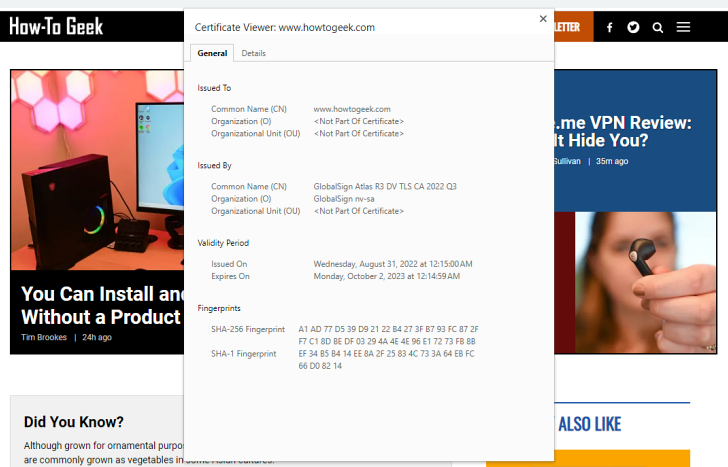
To create an encrypted connection with a website, a web browser, such as Chrome or Firefox, first attempts to verify that website’s SSL certificate. It’s a digital certificate that verifies the identity and security of a website and includes information such as the domain name, the organization name, the issuing authority, the certificate expiry date, and a public key. Once satisfied with the SSL certificate details, the browser generates a random session key and uses the public key included in the certificate to encrypt it. This information is then shared with the website server that uses its private key to decrypt it, following which both can safely communicate without worrying about someone intercepting the data.
Why Is My Connection Not Private?
A problem with a website’s SSL certificate can cause your connection to be not private. For example, if the certificate has expired, is invalid, or is not set up correctly, the browser deems the website unsafe. There can also be other issues, such as a mismatch between the actual domain of the webpage and the domain mentioned in the certificate. Or, in the worst-case scenario, a malicious actor has compromised the website server.
Besides the problems on the website’s end, issues with your computer clock, Wi-Fi network, or browser cache can also lead to errors such as “this connection is not private.”
How to Fix “Your Connection Is Not Private” Error
Although several privacy or SSL errors will require intervention from the website owner, you can try to get rid of the “Your connection is not private” error by attempting the following fixes.
Check Your Computer’s Clock
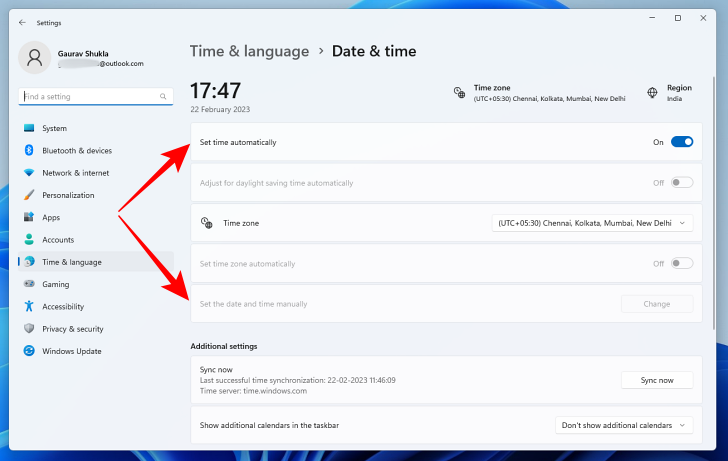
One of the causes for the “ERR_CERT_DATE_INVALID” or “SEC_ERROR_EXPIRED_CERTIFICATE” error codes is the wrong system date or time. You can remedy this by updating your computer’s date and time or by choosing the option to update it automatically.
If you are using Windows, you can right-click the date and time in the taskbar and choose the “Adjust Date and Time” option. Once in the “Date & Time” settings, you can choose to enable “Set time automatically” to get the correct date and time from Windows server, or you can click on “Set the Date and Time Manually” to change the date and time on your computer yourself. Confirming the time zone while you’re in the settings is also a good idea.
On a Mac, you’ll find “Date & Time” settings in System Settings, which you can access by clicking on the Apple menu in the top-left corner of your screen. Once in “System Settings,” look under General for “Date and time.” Like Windows, you can enable the “Set time and date automatically” option here or manually set the date and time.
Sign In to the Public Wi-Fi Portal
Some public Wi-Fi hotspots require you to log in to access free internet. But to reach the sign-in page, you often have to open a website. But if you try to open a secure website, your browser may throw a privacy error as it doesn’t have access to the internet to check the SSL certificate. So it’s better to open a website that doesn’t require a secure connection. HTTP Forever is an excellent option to bookmark for when you might need a “nonsecure” website to open the Wi-Fi captive portal.
Once you’re signed in to the Wi-Fi portal, your browser will stop saying your connection is not private.
Temporarily Disable Your Antivirus
If you use an antivirus that provides a feature like HTTPS protection, HTTPS scanning, Encrypted Web Scan, or Encrypted connections scanning, it may interfere with the browser’s attempts to create a secure connection. So you can temporarily disable the antivirus to see if the issue goes away. If the page works after turning off the antivirus, you can contact the developer for a permanent solution or switch to a different antivirus software, like Windows Defender.
Open the Website in the Browser’s Incognito Mode

Some browser extensions can also cause the browser to show the “connection not private” error. You can confirm this by opening the website or webpage in Incognito mode, which typically keeps all extensions disabled. An extension is likely responsible if the webpage opens without any privacy errors.
Then, you can disable all extensions in the regular mode and switch on one extension at a time to find the culprit. Remember, while all extensions are disabled by default in Incognito mode, there is an option to enable them. So ensure all extensions are disabled before you open the webpage in Incognito. An Incognito window is known as an InPrivate window on Edge and a Private window on Firefox and Safari.
Clear the Browser Cache
Your web browser’s cache stores temporary data from the websites you visit. But sometimes, this cache can become corrupted or outdated, which could hamper a browser’s ability to verify a website’s SSL certificate properly. To fix this, you need to clear your browser’s cache and cookies.
To clear the cache on Chrome, click the three-dot menu icon, then navigate to More Tools > Clear Browsing Data. Next, select “All time” from the time range drop-down and check the boxes next to “Cookies And Other Site Data” and “Cached Images And Files.” Finally, click on the “Clear data” button.
Similarly, in Edge, click the three-dot menu icon, then navigate to Settings > Privacy, Search, and Services > Choose What to Clear. Next, select “Cached Images and Files” from the list, and click “Clear Now” to clear Edge’s cache and cookies.
Firefox users will have to click on the hamburger icon and navigate to Settings > Privacy & Security > Cookies and Site Data > Clear Data. Then, check the boxes next to “Cookies and Site Data” and Cached Web Content,” and click “Clear.”
If you are using Safari and want to delete your data, click on “History” in the top menu and select “Clear History.” You can then select “all history” from the drop-down and hit the “Clear History” button.
Update the Operating System
Privacy errors can also be triggered by outdated system software. So it’s a good idea to update your device to the latest operating system version. Even if this doesn’t fix the issue, you should still keep the device software up to date. To help you do this, we have guides on updating Windows 11, updating Windows 10, updating macOS, updating a Chromebook, updating Ubuntu, and updating iPhones and Android phones too.
Contact the Website Owner
If the problem persists after trying the fixes mentioned above, there is nothing you can do on your own. It’s best to contact the website owner or administrator with the privacy error you are facing and ask them to fix it.
RELATED: What Is a 500 Internal Server Error, and How Do I Fix It?
How to Bypass the “Your Connection Is Not Private” Error
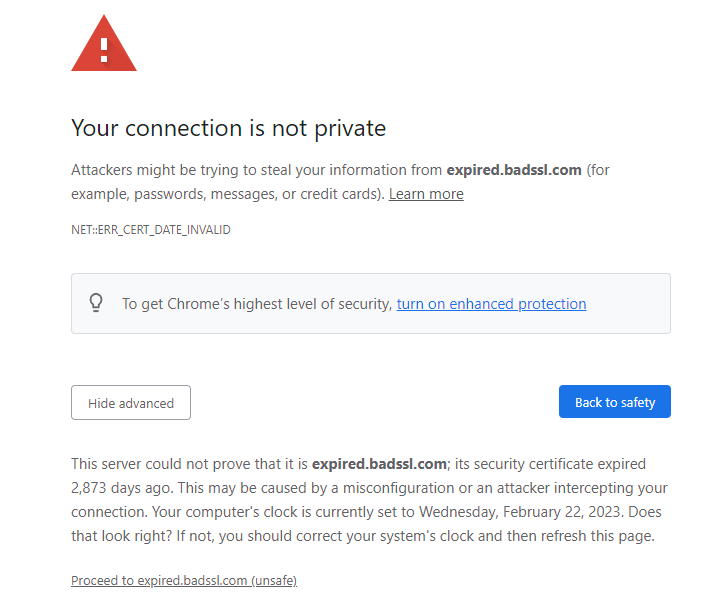
While it’s typically not recommended to bypass the “your connection is not private” error, you can make an exception if you trust the website and your connection to it. You can also skip the error if you understand the technical reason why the browser has generated that particular error and are willing to risk communicating over a vulnerable connection.
To bypass the security warning, click “Advanced” on Chrome, Firefox, and Edge, or “Show Details” on Safari. Then, you can choose to continue to the webpage.
Privacy Error Variations and Codes Explained
The “connection not private” errors may look different depending on which web browser you are using. And sometimes, these errors are also accompanied by technical-sounding error codes that can be worrying. If you’re trying to troubleshoot the exact cause of your privacy error, use these codes to investigate further.
“Your Connection Is Not Private” Error in Chrome
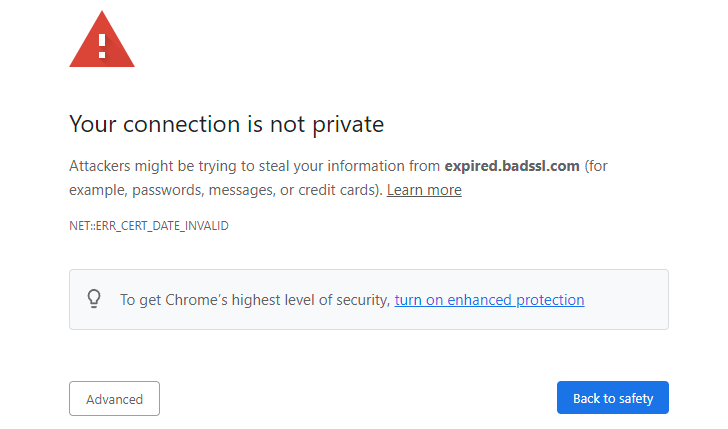
A privacy error on Chrome typically appears as a “Your connection is not private” message accompanied by a red warning symbol. But often, the message will also include one of the following error codes.
- NET::ERR_CERT_AUTHORITY_INVALID: The website’s SSL certificate is either self-signed or from an untrustworthy certificate authority (CA).
- ERR_CERT_COMMON_NAME_INVALID: This error occurs when the domain name mentioned in the SSL certificate doesn’t match the website’s domain name.
- NET::ERR_CERT_WEAK_SIGNATURE_ALGORITHM: The weak signature algorithm error is a result of using the SHA-1 signature hashing algorithm by the SSL CA. SHA-1 was proven insecure in 2017, and now SHA-2 has become the standard hashing algorithm.
- ERR_CERTIFICATE_TRANSPARENCY_REQUIRED: The CA must add all SSL certificates to Certificate Transparency (CT) logs. When that doesn’t happen, website visitors will encounter the certificate transparency required error code.
- ERR_SSL_VERSION_OR_CIPHER_MISMATCH: You’ll encounter an SSL version or cipher mismatch error when the Transport Layer Security (TLS) protocol version used by the website server is older or it’s using RC3 ciphers.
- ERR_CERT_DATE_INVALID: If the expiry date mentioned in the SSL certificate is older than the system date, you may encounter this error.
- ERR_CERT_SYMANTEC_LEGACY: This error appears because Chrome no longer trusts SSL certificates issued by Symantec before June 1, 2016.
- ERR_CERT_REVOKED: The primary reason for this error code is the revocation of a website’s SSL certificate by the CA.
“Your Connection Isn’t Private” Error in Edge

The privacy errors in Edge browser look similar to Chrome, and you get the red warning symbol along with the “Your connection isn’t private” message and the related error codes. But sometimes, you may also get a “The connection for this site is not secure” warning page.
“Warning: Potential Security Risk Ahead” Error in Firefox
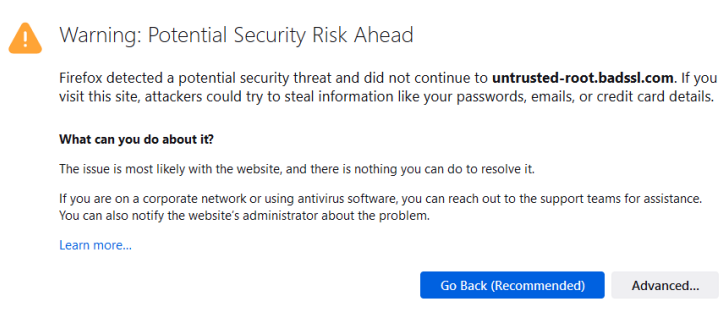
Firefox uses a number of privacy or security warning messages when it encounters an unsafe or misconfigured website. “Warning: Potential Security Risk Ahead” is one of the common warnings. But you may also get “Secure Connection Failed,” “Did Not Connect: Potential Security Issue,” or “Your connection is not secure.” Most of these warnings are typically accompanied by some explanation about the potential security issue or an error code. Here are some common error codes you may see on Firefox.
- SSL_ERROR_UNSUPPORTED_VERSION: Firefox no longer supports TLS protocols older than version 1.2. So if a website uses version TLS 1.1 or older, you will get this error code.
- SEC_ERROR_UNKNOWN_ISSUER: If the SSL certificate issuing authority is unknown to Firefox or the certificate is self-signed, the browser shows this error code. MOZILLA_PKIX_ERROR_SELF_SIGNED_CERT is another error code shown when a website has a self-signed certificate. Or you may get MOZILLA_PKIX_ERROR_ADDITIONAL_POLICY_CONSTRAINT_FAILED code if the website uses an SSL certificate from Symantec, including those issued under the GeoTrust, RapidSSL, Thawte, and Verisign brands.
- SEC_ERROR_EXPIRED_CERTIFICATE: As the name suggests, you will get this error code when Firefox believes the SSL certificate has expired.
- SEC_ERROR_REVOKED_CERTIFICATE: This one is self-explanatory. You will typically see when the certificate issuing authority has revoked the SSL certificate of a domain.
- SSL_ERROR_BAD_CERT_DOMAIN: Firefox shows the “bad cert domain” error when the domain or sub-domains mentioned in the certificate don’t match the webpage domain. It typically happens when all sub-domains aren’t mentioned in the SSL certificate.
- SEC_ERROR_REUSED_ISSUER_AND_SERIAL: If the SSL certificate of the website has the same serial number as another certificate.
“This Connection Is Not Private” Error in Safari
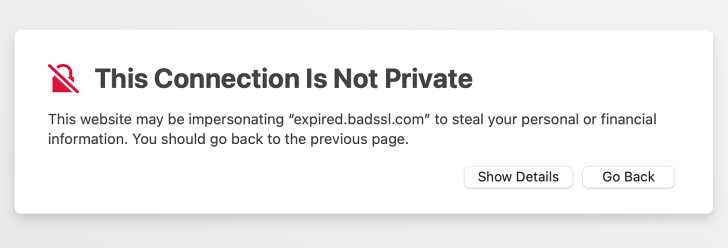
If you are trying to visit a potentially unsafe or misconfigured website on Safari, the browser presents a “This connection is not private” warning page. Unlike Chrome, Firefox, or Edge browser, it doesn’t have an error code, but you can click “Show Details” to find more information about the issue.
Protecting Your Privacy Online
A secure connection between your browser and a website is vital for the safe exchange of information. This is why modern web browsers warn you when you are trying to visit a potentially unsafe website. But often, a problem with your web browser or system can also result in a privacy error.
You can try the fixes mentioned above to resolve any issues with your system. But if none work, it’s best to contact the website owner and wait for it to get fixed to avoid risking your private information.
